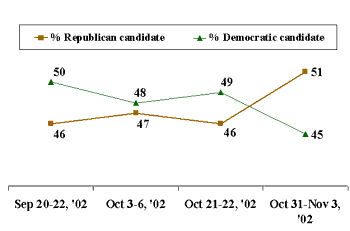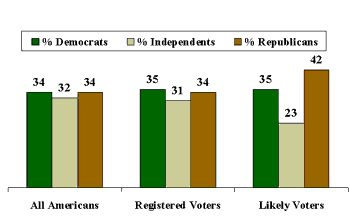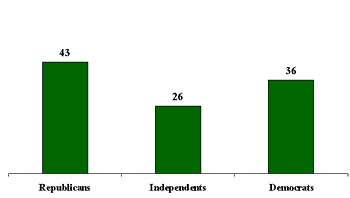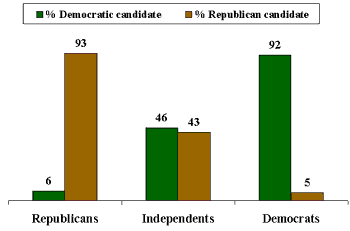GALLUP NEWS SERVICE
PRINCETON, NJ -- The last CNN/USA Today/Gallup survey before Tuesday's congressional elections shows a decided shift in sentiment among likely voters toward Republicans, suggesting the GOP is likely to retain majority control of the U.S. House of Representatives. Two weeks ago, Democrats led among likely voters by three points, 49% to 46%, but the latest poll shows Republicans leading by six points, 51% to 45% -- a nine-point swing in the lead.
| If the elections for Congress were being held
today, which party's candidate would you vote for in your
congressional district? (among likely voters) |
 |
The shift in support toward Republicans is not as dramatic among all registered voters as among likely voters. Democrats led among registered voters by nine points two weeks ago, and in the latest poll they maintain a lead, though it is now at five points, 49% to 44%.
| If the elections for Congress were being held
today, which party's candidate would you vote for in your
congressional district? (among registered voters) |
 |
The six-point Republican lead among likely voters is close to what the last CNN/USA Today/Gallup pre-election poll showed in 1994, when Republicans led 51% to 44% and went on to win 230 seats. The Republicans currently hold 223 seats, Democrats hold 208, and another three are vacant (formerly held by Democrats). One seat is held by an independent, who votes with the Democrats on organizational issues and is expected to win re-election this year.
Greater Turnout Among Republicans
The better Republican showing among likely voters than among registered voters reflects the greater turnout expected among Republicans than Democrats. The poll shows that among all Americans, there are about the same number of Republicans as Democrats (34% each), and almost as many independents (32%). Among registered voters, the distribution is almost the same, suggesting that all three groups tend to register at about the same rate. However, among the group of Americans whom Gallup assesses to be the most likely to vote, Republicans outnumber Democrats by 42% to 35%, with just 23% who are independent.
| Party Affiliation Among Three Groups |
 |
| Oct 31-Nov 3, 2002 |
Another way of looking at these numbers is to calculate the percentage of each group that is likely to vote. Gallup's likely voter numbers are based on an assumed national turnout of 35% of all Americans, very close to the actual turnout reflected in recent elections (turnout was 36% in 1986 and 1998, 37% in 1990, and 39% in 1994). Given this overall turnout level, Gallup calculates that the turnout rate among Republicans will be about 43%, among independents 26%, and among Democrats 36%. These rates are almost identical to the figures found in Gallup's 1998 final midterm election poll, which showed a turnout rate of 43% among Republicans, 27% among independents, and 36% among Democrats. In 1994, turnout was higher among all three groups (49% Republican, 34% independent, and 40% Democrat).
| Percentage of Each Party .Expected to Vote in Congressional Elections |
 |
| Oct 31-Nov 3, 2002 |
The importance of turnout is that voters who identify with a party overwhelmingly vote for that party's candidate in the congressional elections. According to the poll, Republicans will vote for their party's candidates in this year's elections by 93% to 6%, while Democrats will vote for their party's candidates by virtually the same margin, 92% to 5%. Independents show a slight preference for Democrats, 46% to 43%.
| Vote for Congress Compared by Party Identification |
 |
| Likely Voters -- Oct 31-Nov 3, 2002 |
If the turnout rates were the same among all three groups, Democrats would enjoy a slight edge in the national vote for Congress, given their advantage among independents. But because turnout is likely to be much greater among Republicans than Democrats and independents, the GOP leads in the projected vote.
Another related factor that may be contributing to the Republican lead is the active campaigning by President George W. Bush, whose approval rating after almost two terms in office is among the highest ever measured by Gallup. Just over half of likely voters say their vote will be intended as a message to Bush -- 35% saying it indicates support of the president, while half that number, 18%, say it will indicate their opposition.
Will your vote for a candidate be made in order to send a message that you SUPPORT George W. Bush, be made in order to send a message that you OPPOSE George W. Bush, or will you NOT be sending a message about George W. Bush with your vote?
|
|
|
|
DON'T PLAN TO VOTE (vol.) |
|
|
|
Likely Voters |
|||||
|
George W. Bush |
|||||
|
2002 Oct 31-Nov 3 |
35% |
18 |
45 |
1 |
1 |
|
Bill Clinton |
|||||
|
1998 Oct 29-Nov 1 |
23% |
23 |
52 |
* |
2 |
|
(vol.) Volunteered response |
|||||
|
* Less than 0.5% |
|||||
These numbers suggest a greater intent by this year's voters to send a positive message to the president than what happened in the last midterm election. In 1998, voters were evenly divided in their intentions to send a positive or a negative message to President Bill Clinton.
Survey Methods
Results are based on telephone interviews with -- 1,221 -- national adults, aged 18+, conducted Oct. 31-Nov. 3, 2002. For results based on the total sample of national adults, one can say with 95% confidence that the maximum margin of sampling error is ±3 percentage points.
For results based on the sample of -- 1,061 -- registered voters, the maximum margin of sampling error is ±3 percentage points.
Results based on likely voters on the subsample of -- 715 -- survey respondents deemed most likely to vote in the November 2002 midterm elections, according to a series of questions measuring current voting intentions and past voting behavior. For results based on the total sample of likely voters, one can say with 95% confidence that the margin of sampling error is ±4 percentage points.
In addition to sampling error, question wording and practical difficulties in conducting surveys can introduce error or bias into the findings of public opinion polls.
If the elections for Congress were being held today, which party's candidate would you vote for in your Congressional district -- [ROTATE: 1) The Democratic Party's candidate or 2) The Republican Party's candidate]?
As of today, do you lean more toward -- [ROTATE: 1) The Democratic Party's candidate or 2) The Republican Party's candidate]?
|
Democratic |
Republican |
Undecided/ |
|
|
% |
% |
% |
|
|
Likely Voters |
|||
|
2002 Oct 31-Nov 3 |
45 |
51 |
4 |
|
2002 Oct 21-22 |
49 |
46 |
5 |
|
2002 Oct 3-6 |
48 |
47 |
5 |
|
2002 Sep 20-22 |
50 |
46 |
4 |
|
Registered Voters |
|||
|
2002 Oct 31-Nov 3 |
49 |
44 |
7 |
|
2002 Oct 21-22 |
50 |
41 |
9 |
|
2002 Oct 3-6 |
48 |
43 |
9 |
|
2002 Sep 20-22 |
48 |
43 |
9 |
|
2002 Sep 2-4 |
46 |
43 |
11 |
|
2002 Aug 19-21 |
50 |
42 |
8 |
|
2002 Jul 26-28 |
48 |
42 |
10 |
|
2002 Jun 28-30 |
44 |
49 |
7 |
|
2002 Jun 21-23 |
50 |
42 |
8 |
|
2002 May 28-29 |
45 |
46 |
9 |
|
2002 Apr 29-May 1 |
48 |
44 |
8 |
|
2002 Apr 5-7 |
50 |
43 |
7 |
|
2002 Mar 22-24 |
46 |
46 |
8 |
|
2002 Feb 8-10 |
43 |
47 |
10 |
|
2002 Jan 25-27 |
44 |
46 |
10 |
|
2002 Jan 11-14 |
43 |
46 |
11 |
|
2001 Dec 14-16 |
43 |
48 |
9 |
|
2001 Nov 2-4 |
45 |
45 |
10 |
|
2001 Jun 8-10 |
49 |
45 |
6 |
|
Democratic |
Republican |
Undecided/ |
|
|
% |
% |
% |
|
|
National Adults |
|||
|
2002 Oct 31-Nov 3 |
48 |
43 |
9 |
|
2002 Oct 21-22 |
48 |
40 |
12 |
|
2002 Oct 3-6 |
47 |
41 |
12 |
|
2002 Sep 20-22 |
48 |
41 |
11 |
|
2002 Sep 2-4 |
45 |
40 |
15 |
|
2002 Aug 19-21 |
49 |
41 |
10 |
|
2002 Jul 26-28 |
47 |
40 |
13 |
|
2002 Jun 28-30 |
44 |
46 |
10 |
|
2002 Jun 21-23 |
48 |
40 |
12 |
|
2002 May 28-29 |
44 |
45 |
11 |
|
2002 Apr 29-May 1 |
47 |
43 |
10 |
|
2002 Apr 5-7 |
50 |
40 |
10 |
|
2002 Mar 22-24 |
45 |
43 |
12 |
|
2002 Feb 8-10 |
42 |
44 |
14 |
|
2002 Jan 25-27 |
45 |
44 |
11 |
|
2002 Jan 11-14 |
44 |
44 |
12 |
|
2001 Dec 14-16 |
44 |
46 |
10 |
|
2001 Nov 2-4 |
43 |
44 |
13 |
|
2001 Jun 8-10 |
50 |
43 |
7 |
